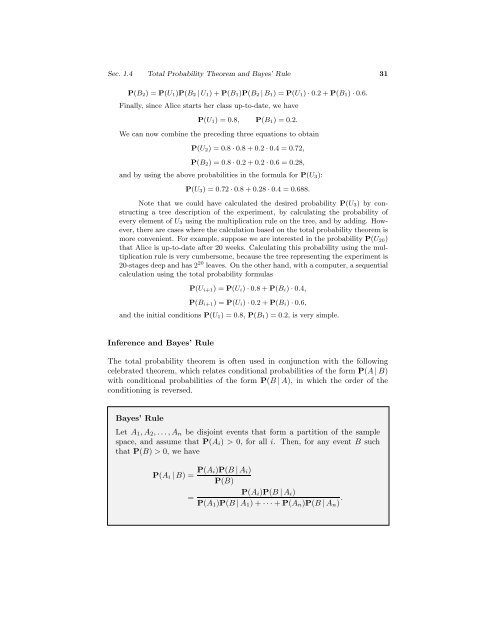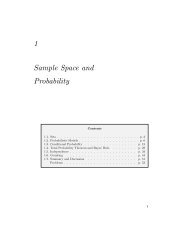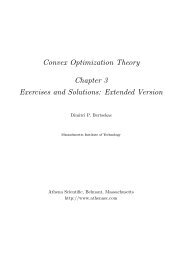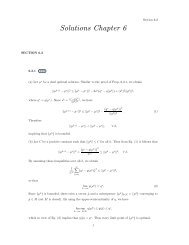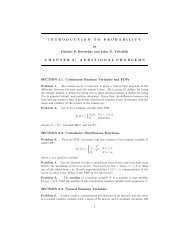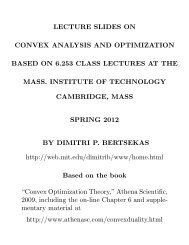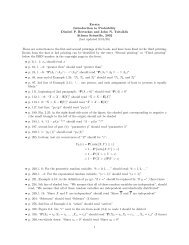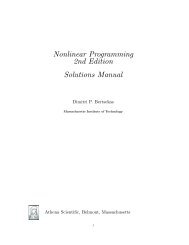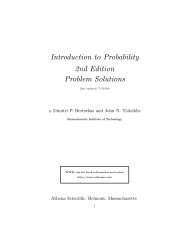Introduction to Probability, by Dimitri P ... - satrajit mukherjee
Introduction to Probability, by Dimitri P ... - satrajit mukherjee
Introduction to Probability, by Dimitri P ... - satrajit mukherjee
You also want an ePaper? Increase the reach of your titles
YUMPU automatically turns print PDFs into web optimized ePapers that Google loves.
Sec. 1.4 Total <strong>Probability</strong> Theorem and Bayes’ Rule 31<br />
P(B 2)=P(U 1)P(B 2 | U 1)+P(B 1)P(B 2 | B 1)=P(U 1) · 0.2+P(B 1) · 0.6.<br />
Finally, since Alice starts her class up-<strong>to</strong>-date, we have<br />
P(U 1)=0.8, P(B 1)=0.2.<br />
We can now combine the preceding three equations <strong>to</strong> obtain<br />
P(U 2)=0.8 · 0.8+0.2 · 0.4 =0.72,<br />
P(B 2)=0.8 · 0.2+0.2 · 0.6 =0.28,<br />
and <strong>by</strong> using the above probabilities in the formula for P(U 3):<br />
P(U 3)=0.72 · 0.8+0.28 · 0.4 =0.688.<br />
Note that we could have calculated the desired probability P(U 3)<strong>by</strong>constructing<br />
a tree description of the experiment, <strong>by</strong> calculating the probability of<br />
every element of U 3 using the multiplication rule on the tree, and <strong>by</strong> adding. However,<br />
there are cases where the calculation based on the <strong>to</strong>tal probability theorem is<br />
more convenient. For example, suppose we are interested in the probability P(U 20)<br />
that Alice is up-<strong>to</strong>-date after 20 weeks. Calculating this probability using the multiplication<br />
rule is very cumbersome, because the tree representing the experiment is<br />
20-stages deep and has 2 20 leaves. On the other hand, with a computer, a sequential<br />
calculation using the <strong>to</strong>tal probability formulas<br />
P(U i+1) =P(U i) · 0.8+P(B i) · 0.4,<br />
P(B i+1) =P(U i) · 0.2+P(B i) · 0.6,<br />
and the initial conditions P(U 1)=0.8, P(B 1)=0.2, is very simple.<br />
Inference and Bayes’ Rule<br />
The <strong>to</strong>tal probability theorem is often used in conjunction with the following<br />
celebrated theorem, which relates conditional probabilities of the form P(A | B)<br />
with conditional probabilities of the form P(B | A), in which the order of the<br />
conditioning is reversed.<br />
Bayes’ Rule<br />
Let A 1 ,A 2 ,...,A n be disjoint events that form a partition of the sample<br />
space, and assume that P(A i ) > 0, for all i. Then, for any event B such<br />
that P(B) > 0, we have<br />
P(A i | B) = P(A i)P(B | A i )<br />
P(B)<br />
P(A i )P(B | A i )<br />
=<br />
P(A 1 )P(B | A 1 )+···+ P(A n )P(B | A n ) .


